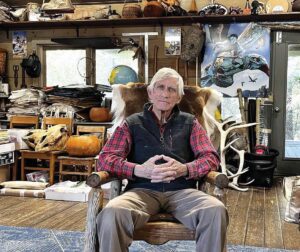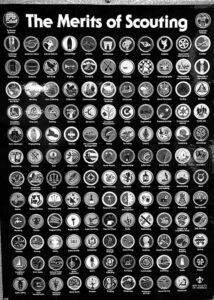How did you get interested in the natural world? While this seems like an obvious question for someone who has spent several decades as a Naturalist in Residence for a local private school, the obvious answer looms as clearly as sunrise each morning.
Rudy Mancke is easily the most famous naturalist in South Carolina, maybe the most famous person in the state. He’s been on local TV more than Andy Griffith, and his recent passing leaves a hole that might never be filled.
Tom Mancke is five years younger than his oldest brother and, after a chuckle, confirmed the easy answer, “Following Rudy around. He had discovered the local library, and we lived near Duncan Park Lake. Rudy had been bitten by a snake and assumed he was dying. After a few days he began studying snakes to understand why he was still alive.”
That exercise led to many other excursions into the outside world. “I was the youngest of four children and was interested in everything. My siblings each had a single focus on something. Rudy was fascinated by the natural world. My sister loved music and brother Jim became a psychologist and high school counselor,” said Tom.
Tom followed Rudy the most, as did the other kids in the neighborhood. “ We all followed Rudy around. He was our Guru,” he said.
Tom remembers the boys’ paper route as being a catalyst for expanding knowledge about animals by picking up roadkill during the delivery process and taking them to a shack in the neighborhood. Later in the day, the boys would dissect the deceased animal to see what was inside.
After solving the mysteries of dead possums, the boys used their shack to build weather monitoring devices, again from library books, and eventually discovered chemistry sets. Building model rockets and creating their own “jet fuel” was next. Whether that shack withstood those shenanigans wasn’t revealed.
Tom is a storyteller, where his famous brother was a teacher. His inability to decide which path to take, like all his siblings, resulted in a curious and varied path toward his eventual permanent profession. “I envy people who know what they want. I was easily distracted and unable to focus on one thing,” he said.
Tom was a biology major who got a job at a Coca-Cola bottling company, followed by a substitute teacher stint. He did some construction and got a position at USC called animal care supervisor.
“I eventually returned to school to take theatre classes and got a second degree in Philosophy,” Tom said. After some failed projects, he got work in field engineering. He was working there when he heard from Dr. Herb Barks, recently hired headmaster at Hammond School.
Dr. Barks had tried to hire brother Rudy to teach at Hammond. Rudy turned him down but told him to call his brother. Tom accepted a science teacher position initially, but felt it wasn’t right for him. After turning down a second year in the same position, Tom was offered the position of Naturalist in Residence. “You mean I get to take small groups of kids into the woods?” he asked.
Over 35 years later he is still doing that, although Tom insists a chance meeting with a primitive skills teacher was influential in the process.
“While I was struggling with the science class, Dr. Barks sent Mark Warren, a primitive skills guy who ran a school for outdoor survival to offer guidance,” Tom said. “While telling the kids a story about the Native American origin story for fire, he built one using sticks. I was amazed at how the story fit the demonstration.”
Tom says in his current position he is really “trying to be Rudy but also my brother, Jim, in a lot of ways. I also wish I could be my sister, Cathy, but I’m not good at music.”
The heartbeat of the Hammond School Naturalist in Residence is The Cabin. “I love digital technology,” Tom says, as he wiggles his fingers. “Using our hands to learn things is the best way to learn. I also have a wall full of merit badges from Boy Scouts.”
Tom says, “ The Scout’s motto, Be Prepared, has always haunted me.” He wonders what we’re supposed to be prepared for, so he focuses his lessons on learning new skills.
Plans for the cabin began during a field trip to Williamsburg. Tom and Dr. Barks along with several fifth grade students were enjoying the activities of ancient Williamsburg when Tom mentioned, “We can do this on campus if we have a cabin.”
Tom had been shuffled from place to place and needed a permanent classroom.
A fundraising plea and expert building from Southland Log Homes resulted in a shiny new nature cabin, along with several other facility structures. That was in 1996. While the structure is filled with stuff, Tom insists it isn’t cluttered. But if anyone has an old cabin lying around not being used, Tom would love to have the extra space.
Every wall is lined with books. There are large mammal bones scattered around the entirety of the cabin, and, like any good cabin, canoes and snowshoes hang from the ceiling. Tom’s merit badge collection is in a prominent place along with several photos of Steve Watts, a “mentor of mine” along with Mark Warren, the primitive skills teacher Tom was affected by early in his career. Artifacts, memorabilia, ancient tools, and keepsakes are scattered over any flat space. Ancient rocks, “the bones of the Earth,” are everywhere. There are even small racks of the skins of deer feet drying.
Among the many projects designed, invented, and stolen from other sources was heading to Phillips Plantation after dark and asking the folks there for their deer feet while they were butchering the day’s harvested animals.
Native Americans used every morsel of the animals they killed. Taking the feet and dissecting them, sometimes with cutting tools made from river rock, and saving every bit of material, is among the more involved of the demonstrations overseen by the Naturalist in Residence.
A current project to design and build a soap box derby racer is underway. The surrounding grounds feature Stonehenge-like displays patterned after ancient studies into the summer and winter solstice. Fifth graders even have a Primitive Technology Week.
The youngest of the Mancke children, despite his self-proclaimed weaknesses, has built something powerful at Hammond School. Through his unlimited interest in the world he lives in, and the innate ability to tell stories about how things happened and how they affect the surrounding space, he has developed a learning machine.
Some have returned after decades away, sporting lofty titles like archeologist and professor. Most of them have moved on quietly and are doing good things based on lessons they learned while wandering around the woods. And wondering, “Why?”
Perhaps the Youngest Mancke says it best, “We’re born into this mystery, let’s face it, and we don’t like mysteries. We have to come up with stories to explain it. And we hug those stories. If we come to question our stories? Not a fun place to be. We have to search for better stories.”




Loading Comments